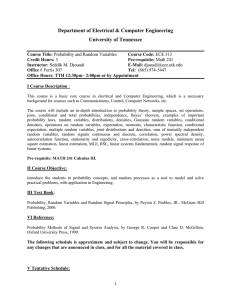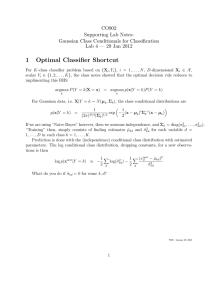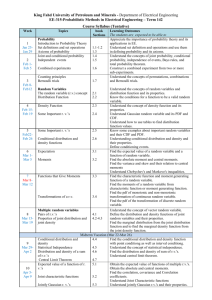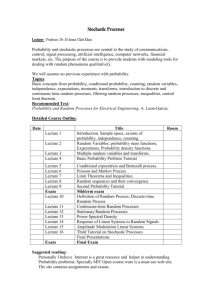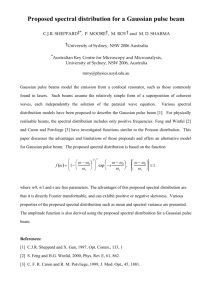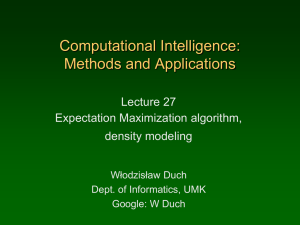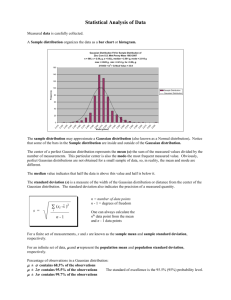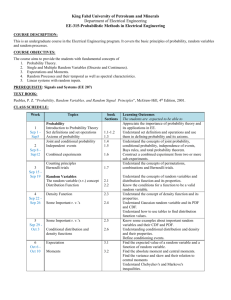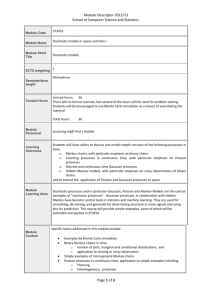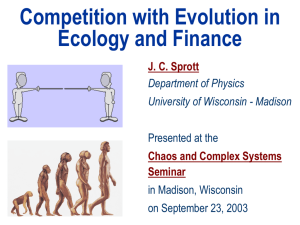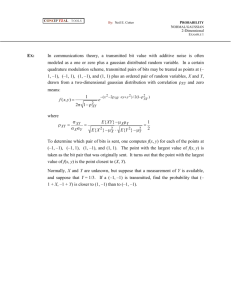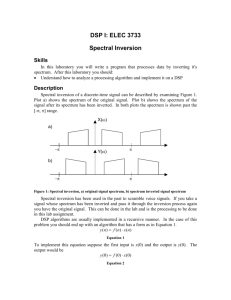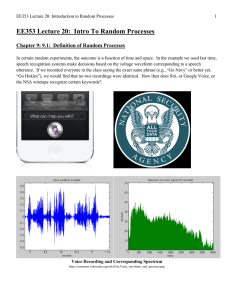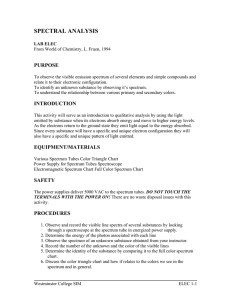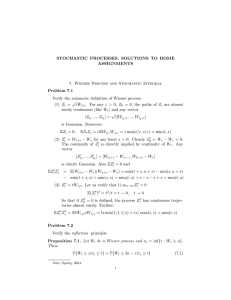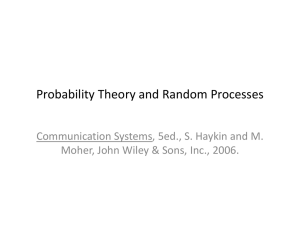Probability and Random Variables Syllabus
advertisement
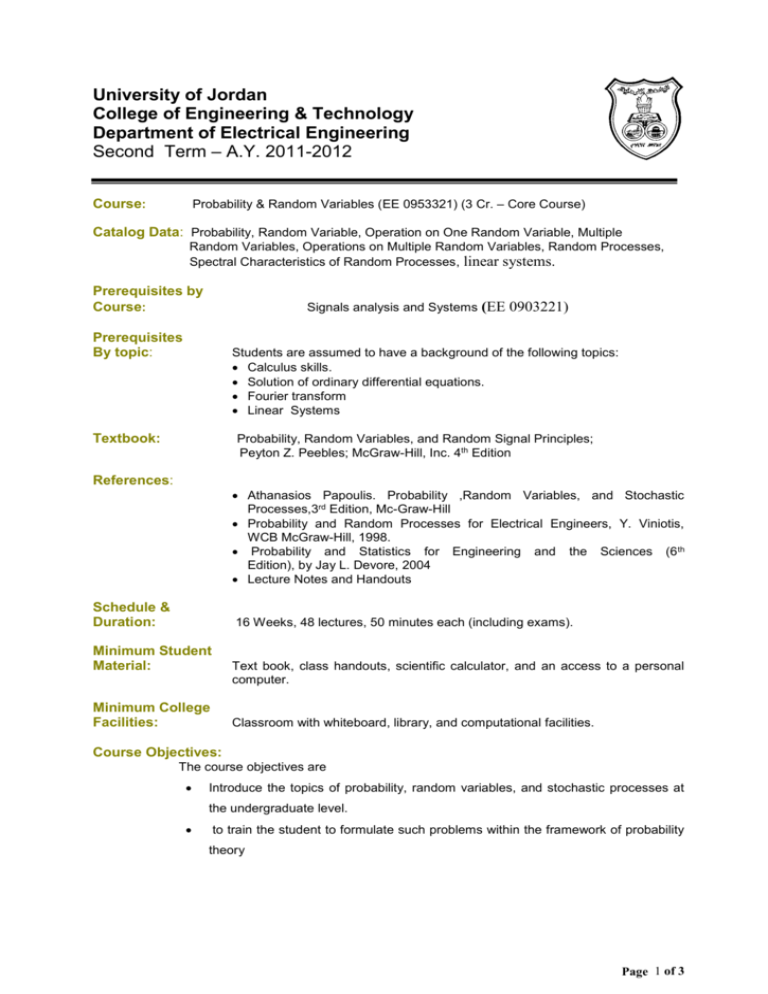
University of Jordan College of Engineering & Technology Department of Electrical Engineering Second Term – A.Y. 2011-2012 Probability & Random Variables (EE 0953321) (3 Cr. – Core Course) Course: Catalog Data: Probability, Random Variable, Operation on One Random Variable, Multiple Random Variables, Operations on Multiple Random Variables, Random Processes, Spectral Characteristics of Random Processes, linear systems. Prerequisites by Course: Signals analysis and Systems Prerequisites By topic: (EE 0903221) Students are assumed to have a background of the following topics: Calculus skills. Solution of ordinary differential equations. Fourier transform Linear Systems Textbook: Probability, Random Variables, and Random Signal Principles; Peyton Z. Peebles; McGraw-Hill, Inc. 4th Edition References: Athanasios Papoulis. Probability ,Random Variables, and Stochastic Processes,3rd Edition, Mc-Graw-Hill Probability and Random Processes for Electrical Engineers, Y. Viniotis, WCB McGraw-Hill, 1998. Probability and Statistics for Engineering and the Sciences (6 th Edition), by Jay L. Devore, 2004 Lecture Notes and Handouts Schedule & Duration: 16 Weeks, 48 lectures, 50 minutes each (including exams). Minimum Student Material: Text book, class handouts, scientific calculator, and an access to a personal computer. Minimum College Facilities: Classroom with whiteboard, library, and computational facilities. Course Objectives: The course objectives are Introduce the topics of probability, random variables, and stochastic processes at the undergraduate level. to train the student to formulate such problems within the framework of probability theory Page 1 of 3 Course Outcomes and Relation to ABET Program Outcomes: Upon successful completion of this course, a student should be able to:: 1. Convert an Engineering statment problem into a precise mathematical probabilistic Statement . 2. Use statistical principles and the properties of random variables to solve Probabilistic problems . 3. Calculate standard statistics from mass, distribution and density functions . 4. Recognize , interpret and apply a variety of deterministic and nondeterministic random Processes that occur in engineering . 5. Calculate the autocorrelation and spectral density of a random process and recognize the relation beteen them.. 6. Understand stochastic phenomena such as white and colored noise . 7. Understand linear systems. And their output charactaristics . Course Topics: Contact Hours Topic Description T.1. Probability: Axiomatic definition, use of set concepts, conditional and joint probability, independence, Bays Rule, Total Probability. 5 T.2. Random Variables: 7 Basic concepts, The random variable concept, Distribution function, Density function, The Gaussian random variable, other distribution and density examples, Conditional distribution and density functions Families of distributions. T.3. Operation on One Random Variable 7 Expectation, Moments, Functions that give Moments, Transformations of a random variable, Computer generation of one random variable T.4. Multiple Random Variables 6 Vector random variables, Joint distribution and its properties, Joint density and its properties, Conditional distribution and density, Statistical independence, Distribution and density of a sum of random variables, Central limit theorem T.5 Operations on Multiple Random Variables 6 T.6 Expected value of a function of random variables, Joint characteristic function, Jointly Gaussian random variables, Transformations of multiple random variables, linear transformation of Gaussian random variables, Computer generation of multiple random variables Random Processes 7 Page 2 of 3 The random process concept, Stationarity and independence, Correlation functions, Measurement of correlation functions, Gaussian random processes, Poisson random process T.7 Spectral Characteristics of Random Processes 5 Power density spectrum and its properties, Relationship between power spectrum and autocorrelation function, Cross-Power density spectrum and its properties, Relationship between cross-power spectrum and cross-correlation function , some noise definitions and other topics T.8 5 Linear systems. Input output relations of linear systems. Computer Usage: Course work including assignments using software packages, especially Matlab Attendance: Class attendance will be taken every class. Assessments: Exams, Quizzes, and Assignments. Grading policy: First Exam Midterm Exam Final Exam 20 % 30 % 50 % Total 100% Instructor: Last Updated: Instructor Name Office Hasan Farahneh EE dep 3rd floor Ext. 22862 E-mail h.farahneh@ju.edu.jo Feb 1, 2012 Page 3 of 3
